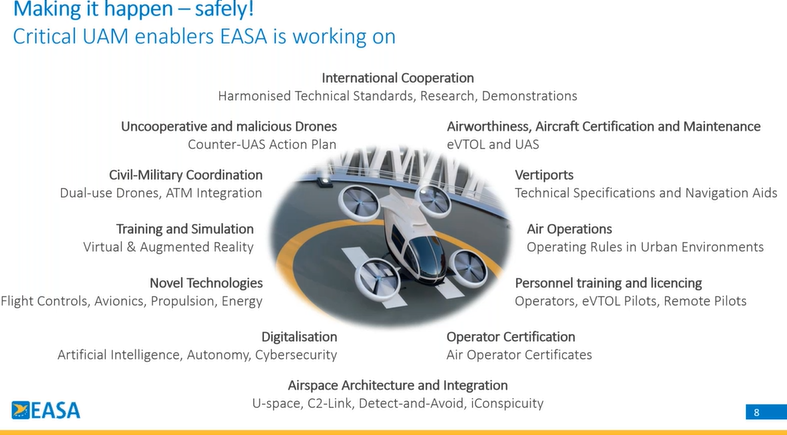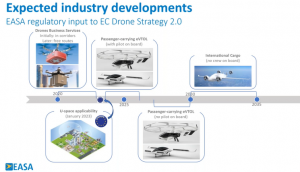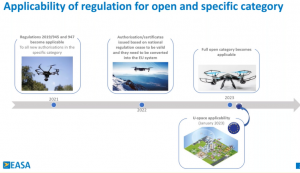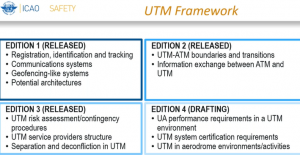
By Jenny Beechener
The European Union Aviation Safety Agency (EASA) predicts passenger flights with no pilot on board by the end of the decade, said Natale Di Rubbo, EASA Drone Project Manager at the AW Drone final public event on 7 December 2021. He expects the first international cargo flights by 2035, followed by larger passenger aircraft in the more distant future. The European Commission’s Drone Strategy 2.0 due adoption in 2022 provides strategic direction for the accompanying standards and rule-making.
To support harmonisation of standards, the AW Drones research and innovation project is providing a repository of technical standards and best practices while validating these standards.
“EASA is the main customer of AW Drones activity,” said Natale Di Rubbo. “We started with a jungle of standards, thanks to this project, we now have better idea how to link standards to our rule-making activity.” Following publication of EU regulation 2021/664 in April 2021 establishing a regulatory framework for initial U-space services, a Notice of Proposed Amendment (NPA) is due to be released in the coming weeks for acceptable means of compliance and supporting guidance material. This paves the way for introduction of the EC’s U-space Implementing Rule in January 2023.
“U-space will not be deployed everywhere, but expand little by little, starting where there is more traffic. It will enable beyond visual line of sight (BVLOS) operations in shared airspace so all users – manned and unmanned – need to comply.”
EASA is also preparing an NPA addressing certification of higher risk Unmanned Aerial System (UAS) that fall into the ‘Specific Category’ – currently assessed as manned aviation – with updated requirements due release in mid-2022 for public consultation. This follows the introduction of standards for ‘Open Category’ UAS planned in early 2022, though as discussions are still ongoing this may be delayed 12 months. EASA regulations are intended to be proportionate to the risks presented by operations, thereby opening the market to new opportunities while maintaining safety.
Natale Di Rubbo said there is a lot still to do to meet the Commission’s directive to enable Unmanned Aerial Mobility (UAM). “Europe is quite advanced; we have identified a lot of what we need, but there are still a lot of challenge areas. For example, we have started an activity on package delivery and air taxis. In 2023 we will publish a proposal that addresses UAM without a pilot onboard, and international flight operations with cargo aircraft that will be available for consultation in 2023 with possible adoption in 2024.”
EASA regulations also support the development of harmonised drone regulations and guidance by ICAO. “We are establishing a common framework for industry and stakeholders to support safe expansion and management of UAS,” said Regional Officer Sven Halle. “We will publish Edition 4 in 2Q22 which will include UAS and UTM system certification requirements”. ICAO will include issues including safety operations risk assessment (SORA), UAS humanitarian operations, carriage of dangerous goods, and societal concerns.
While the webinar showed progress in many areas of industry regulation, the result of surveys conducted by AW Drones examining UAS market sectors, flight mission purposes and risk analysis methods drew attention to knowledge gaps and scarce information among drone users. Peter van Blyenburgh, Blyenbugh CEO said: “Not many respondents understood the intricacies of SORA…even though the majority had significant knowledge and understanding of the drone sector and aviation generally.” He said the general understanding of U-space was below 50%, with many respondents asking for further specification and clarification of rules and guidelines. The information available is currently insufficient with the most urgent services requested by respondents as: flight authorisation request processing; geographical zones designations; and traffic information. On a positive note, most respondents want to be involved in creating standards even though they may not be at present.
AW Drones is finalising a new standards information portal due release at the end of 2021. Project Coordinator Damiano Taurina said: “The online repository provides a single point of access to relevant information about rules, procedures, and technical standards for mass-market drones worldwide and is free to use. The latest version features new logo and intuitive graphical interface that makes it easier to use.” An interactive capability is due to be added in the future to collect information from users.




